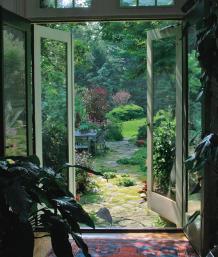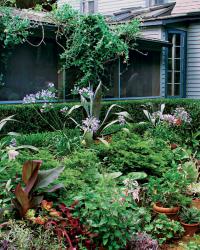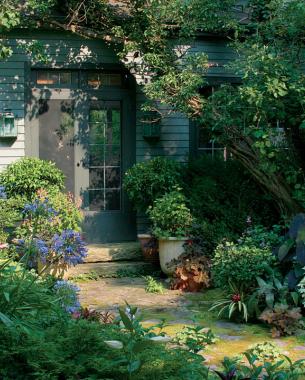
As more and more people are seeing the wisdom of turning their outdoors into usable space, the phrase “outdoor rooms” has become part of our language. With a background in plant science and extension education, Wesley Rouse has been creating gardens and growing specialty plants for almost a quarter century. Today, he is the owner of Pine Meadow Gardens, a design/build landscape firm in Southbury, Connecticut. In this interview, Rouse talks about how he transformed his property from wild meadows and fields to a series of inviting garden rooms.

Photo/Illustration: Matthew Benson


Your landscape is mature and lush. How has it evolved?
Spaces have a way of growing out of how you use the land. When I bought this house 35 years ago, the land around it was a tangle of forsythia, multiflora rose, autumn olive, and overgrown pastureland. I didn’t have an overall plan to begin with, so I started clearing little by little. I added the screened porch (top photo, facing page) and some terraces. Then came a larger addition to the house, which created a protected area that became the outdoor dining room.

Photo/Illustration: Matthew Benson

Photo/Illustration: Matthew Benson
The other two outdoor rooms grew up around entries. The back-door area with its fieldstone patio and wooden benches was created by changing the grade of a slope, which came right down to the back door, and adding a retaining wall. This area is filled with shrubs, perennials, and many potted plants.
The other outdoor sitting area is outside my office, which opens onto a small bluestone patio bordered by a stone wall and a boxwood hedge that loop around a wrought-iron bench. This garden room is tucked away, so it feels private and sheltered, even though it’s right outside the busiest room in the house. This area is also a function of grade. Terraced beds lead up to the main entrance to the house.

Photo/Illustration: Stephanie Fagan
People are often advised to live with a space for a while before changing it.
Yes, it’s true. Unless you’re really experienced, it’s a good idea to allow some time to figure out traffic patterns and be sure of what you need for the way you live. If you have big cocktail parties or family gatherings, you’ll want larger spaces. Or you may want a big space for special occasions and a small space for intimate gatherings.
Living with your space will also allow you to become familiar with the light patterns throughout the year—when you want to be in the sun and when you don’t. Sometimes you don’t have a choice; then you know you’ll have to plant trees or shrubs or build an arbor or pergola for sun protection.
How do you create the hardscape, especially if you’re starting with nothing?
Each case is different and depends on the lay of the land, your needs, the style of your house, and your budget. You can usually start by either capitalizing on the grades you have or creating some interesting variation. If you have a flat yard, for instance, you might want to have a slightly sunken area outside the back door to create a dining area. A simple change in the levels makes the area more interesting.
Hardscaping can take a number of forms: terraces, fencing, stone walls, walkways. Lattice fencing with big squares is an inexpensive way to break up space. The nice thing about hardscaping is that it not only defines an area but also brings elements of the house out into the yard. You have the house and you have the lawns, but it’s not until you introduce a hard surface—stone, wood, brick, bluestone—that the two become blended.
Also, decide if there is a focal point you want to highlight: a lovely tree, a distant view, a beautifully planted urn. You’ll want to be sure the focal point is what you see when you look out from the interior.

How do you get your outdoor rooms to be so cozy?
WR: Foremost, you want the space to have a pleasing size and proportion. Hedges and structural items create line and balance and a certain peacefulness. Then the interior of the space can be formal or informal. It’s fun to have a little bit of structure to create the borders, then have a lot of informality and lushness within—flowing plants, ground covers, and moss—always with an eye toward mixing textures and colors.
How do you work with vistas?
When I’m creating spaces, I often leave an opening, which acts as an invitation to go toward another element in the garden. Most of the outdoor spaces also have views from inside, so if you’re looking out of the doors of the house, you see the enclosed space, then another space beyond, and possibly even an additional space, until it ends somewhere with a view or a focal point. So you’re framing vistas, either with just an opening or with gates, pots, or another structure.
Your house color is perfect for your garden rooms.
The house was white originally, then I played with brown colors; for many years, however, it’s been this blue-gray. The color was selected to blend in and flow with the gardens.
In general, subtle house colors rather than highly reflective ones work best with gardens. You’ll notice that I haven’t used a lot of white. In some situations, white is completely correct, but it does stand out and take away from the integration of house, garden, and hardscape. White picket fences, for instance, are perfect in the right setting, but often they create a line in the landscape and give the fence too much prominence.
How should people go about choosing plant material?
Start with plants you know you like, then branch out. What are your childhood memories? What fragrances appeal to you? What colors do you prefer? Know your planting zone, and be familiar with the sun and shade conditions of the area you’re planting in.
First, choose your key plants, both vertical and horizontal. After that, it’s a matter of filling in with interesting plants, which should be repeated enough times that there’s some kind of pattern.
Don’t forget that houseplants and potted tropicals can be outside for the summer. Pots add a lot to a garden room, but they require quite a bit of maintenance. So you have to balance the complexity of your room with your lifestyle. Your outdoor space should be manageable enough that it’s fun and does not become burdensome.
Stir up the senses


Photo/Illustration: Matthew Benson

Photo/Illustration: Stephanie Fagan
A garden, by its very nature, is sensual, but one that highlights a particular sense can offer an extra measure of enjoyment.
Scent
If you have the right conditions, you can plan for a succession of fragrant plants: perhaps lilacs, peonies, roses, and honeysuckles. A pot of gardenias or a couple of potted citrus trees could be brought in for the winter if you live in a cold climate. Thyme planted around stepping-stones will release its fragrance when stepped on.
Sound
Movement creates sound. Grasses, willows, and bamboo all rustle gently in a breeze. Birdsong, of course, is always pleasant in the garden. The sound of water is soothing and can even cover street noise. If you include a waterfall, however, make it look like it belongs in the environment; to have something that looks artificial is worse than not having it at all.
Sight
The repetition of plant varieties and colors and textures in a garden room creates a subtle rhythm that can produce a feeling of peace and well-being. A mixture of perennials, annuals, and potted plants can provide continuous color.
Touch
A garden room can offer many textures in plant material alone: fuzzy, leathery, or smooth leaves; fluffy, silky, or papery flower heads; soft, damp moss; rough tree bark. In addition to the plants, you may have the smoothness of a hot or cold wrought-iron table, the grainy texture of a wooden bench, or the hardness of a stone patio or rock wall.
Taste
Many plants are edible, including nasturtium, mint, borage, calendula, lavender, lemon verbena, bee balm, and scented geranium. Be sure you know what you have, and don’t spray anything you may want to eat.—Wesley Rouse
Seven tips for the do-it-yourself designer

Evaluate your lifestyle
What kind of outdoor room do you need for the way you live? Be realistic about how much you can maintain.
Keep a notebook of ideas
Look through magazines for appealing gardens that fit the style of your house.
Go on garden tours
The best inspiration often comes from walking around someone else’s garden. Every year, the Garden Conservancy sponsors its Open Days Program at private gardens across the country ( www.gardenconservancy.org ).
Don’t select all your plant material at once
First, choose the structural plants, then put in filler plants as you can. The smaller plants are more fun because they add color, texture, and fragrance to your garden room.
Use critter-resistant plants
If deer are a problem, for example, choose—as much as possible—plants they don’t like. Your university extension service can give advice on plants your local pests will avoid.
Choose hardy plants
Don’t plant shrubs, for instance, that you’ll have to cover with unsightly burlap. Select plants whose structure you can enjoy all year.
Don’t be afraid
Just do it. That is how you learn.
Fine Gardening Recommended Products

A.M. Leonard Deluxe Soil Knife & Leather Sheath Combo
Fine Gardening receives a commission for items purchased through links on this site, including Amazon Associates and other affiliate advertising programs.


















Comments
Got the wonderfull blog convert jpg to pdf free thanks for this.
Incredible article truly intrigued . I figure you ought to likewise compose article about industrial flexible ducts . This will be useful for other people, I surmise bless your heart.
Log in or create an account to post a comment.
Sign up Log in